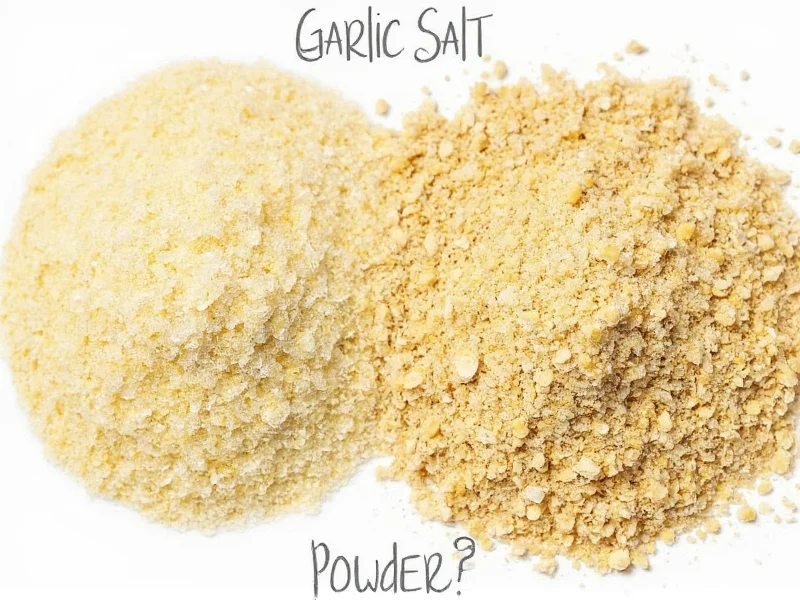Understanding the difference between garlic powder and garlic salt is essential for home cooks and recipe developers. While both provide garlic flavor, their composition creates distinct culinary applications. Garlic powder delivers concentrated garlic essence without added sodium, making it versatile for seasoning without altering a dish's salt balance. Garlic salt, however, introduces both flavor and significant sodium content that can dramatically change a recipe's outcome if substituted incorrectly.
Composition Breakdown: What's Really Inside
Examining the ingredient lists reveals the core distinction between these pantry staples. Pure garlic powder contains only one ingredient: dehydrated garlic that's been ground into a fine powder. The production process involves drying fresh garlic cloves and milling them to a consistent texture without adding any other components.
Garlic salt, by contrast, is a manufactured blend with two primary ingredients: garlic powder and salt. Most commercial varieties maintain a standard ratio of three parts salt to one part garlic powder (3:1), though some brands use a 6:1 ratio. Many also include anti-caking agents like calcium silicate or sodium silicoaluminate to prevent clumping.
| Characteristic | Garlic Powder | Garlic Salt |
|---|---|---|
| Primary Ingredients | 100% dehydrated garlic | Garlic powder + salt (typically 3:1 ratio) |
| Sodium Content per Teaspoon | Negligible (5-10mg) | Approximately 1,200-1,500mg |
| Flavor Profile | Pure garlic essence | Garlic flavor with prominent saltiness |
| Common Additives | None | Anti-caking agents, sometimes sugar |
| Calories per Teaspoon | Approximately 5 | Approximately 10-15 |
Flavor Impact in Cooking Applications
When considering garlic powder vs garlic salt in recipes, the flavor impact differs significantly. Garlic powder provides a clean, pure garlic flavor that integrates smoothly into dishes without altering the salt balance. This makes it ideal for rubs, marinades, and recipes where you control the exact salt content.
Garlic salt's dual flavor profile means it simultaneously seasons with both garlic and salt. This convenience comes with limitations—using garlic salt when a recipe calls for garlic powder can result in oversalted dishes. The reverse substitution (garlic powder for garlic salt) often produces under-seasoned food lacking the intended flavor complexity.
Sodium Content: The Critical Health Consideration
For those monitoring sodium intake, understanding the sodium difference between garlic powder and garlic salt is crucial. A single teaspoon of garlic salt contains approximately 1,200-1,500mg of sodium—nearly half the recommended daily limit for adults. The same amount of garlic powder contains only trace amounts (5-10mg).
This dramatic difference makes garlic powder the preferred choice for low-sodium diets, heart-healthy cooking, and recipes where you need garlic flavor without additional salt. Many commercial garlic salts also contain anti-caking agents that some health-conscious consumers prefer to avoid.
Practical Substitution Guide
When you need to substitute garlic powder for garlic salt (or vice versa), precise conversion is essential. For every 1/4 teaspoon of garlic salt called for in a recipe, use 1/8 teaspoon garlic powder plus a pinch of salt. Conversely, when replacing garlic powder with garlic salt, use one-third the amount of garlic salt and reduce other salt in the recipe accordingly.
Consider these real-world substitution scenarios:
- Homemade seasoning blends: Always use garlic powder to maintain control over sodium levels
- Meat rubs: Garlic powder works better for precise seasoning control
- Quick seasoning: Garlic salt offers convenience when you want both flavors simultaneously
- Low-sodium diets: Garlic powder is the only appropriate choice
Storage and Shelf Life Considerations
Both products share similar storage requirements—cool, dark places in airtight containers—but their shelf lives differ slightly. Pure garlic powder typically maintains peak flavor for 2-3 years when properly stored. Garlic salt usually remains potent for 18-24 months, with the salt component remaining usable indefinitely though the garlic flavor diminishes over time.
Moisture is the enemy of both products. Clumping indicates moisture exposure, which accelerates flavor degradation. If your garlic salt has hardened significantly, the anti-caking agents have likely failed, and the product should be replaced for best results.
Avoiding Common Culinary Mistakes
Many home cooks make critical errors when using these ingredients interchangeably. The most frequent mistake involves using garlic salt when recipes specify garlic powder without adjusting other salt quantities, resulting in oversalted dishes. Another common issue is assuming equal potency, when in reality garlic salt delivers less concentrated garlic flavor due to the salt dilution.
Professional chefs recommend keeping both products in your pantry but using them deliberately. Reserve garlic salt for quick seasoning tasks where convenience outweighs precision, and rely on garlic powder for recipe development and controlled seasoning.
When Each Product Shines: Practical Applications
Certain cooking situations highlight the unique advantages of each product. Garlic powder excels in:
- Recipe development where precise seasoning control matters
- Low-sodium meal preparation
- Dry rubs for meats where consistent texture is important
- Baking applications where salt content must be carefully controlled
Garlic salt works best for:
- Quick seasoning of vegetables or proteins
- Popcorn seasoning and snack applications
- Situations where you want dual seasoning with minimal effort
- Older recipes developed before pure garlic powder was widely available











 浙公网安备
33010002000092号
浙公网安备
33010002000092号 浙B2-20120091-4
浙B2-20120091-4